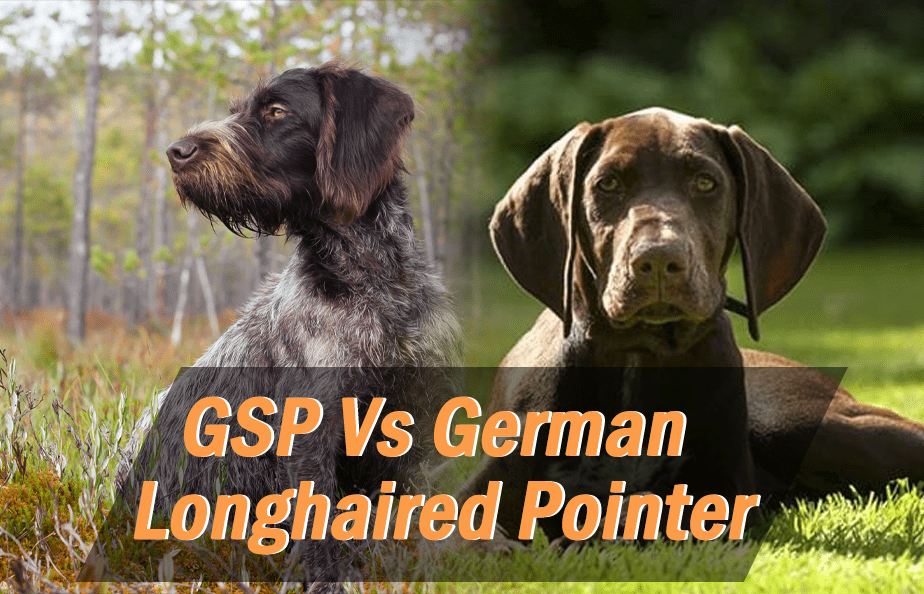Whether longhaired or shorthaired, German Pointer Dogs are very popular in the States. Though all love dogs of every breed, pointer dogs, in particular, are a common breed of dog well known for their multipurpose abilities. They are widely trained by North American hunters to accompany them but are also excellent family dogs.
Comparatively, German Longhaired Pointers are rarer than German Shorthaired or Wirehaired Pointers. They are all hard hunters and display good retrieving skills, but Longhairs are more impressive to watch.
Picking the right breed is essential for you as it will decide how much you’d connect with your pet. There have been many crosses between the three, but you may want to get a single dog to keep you company, as more than one is a handful. So, we will help you decide which is the better breed for you.
Today, in this article, we will we discussing our favorite breeds — German Shorthaired Pointers (GSPs) and German Longhaired Pointers (GLPs), including commonly asked questions such as:
- What is the historical background of the two breeds?
- Which breed is more adaptable?
- What are their health needs?
- How do you care for the breeds?
German Shorthaired Pointer and German Longhaired Pointer are two breeds that share similar backgrounds and breeding purposes; however, there are areas where they differ in. We will discuss the similarities and differences between GSPs vs GLPs in detail, but first, let’s dive into the historical background of both breeds.

What is the historical background of the two breeds?
Let’s begin with how German Shorthaired Pointers were only recognized as a breed in 1930 by the American Kennel Club. This was a lot more recent than the German Longhaired Pointers, who were identified during the year 1978.
Despite GSPs’ recent identification as an official breed, German hunters have long bred since the 1800s. The GSP was one of the winning breeds in competitive events such as hunting. However, GLPs were considered a relatively slow breed, and only after crossing it with English Pointers did they improve their speed.
When it comes to descendants, GSPs are known to have descended from the German Bird Dog, which is related to the Old Spanish Pointer. GLPs, on the other hand, are descendants of the point spaniel. Old and versatile, but they happen to disallow black as a color on their dogs. So, only brown-and-white were considered Longhaired Pointers; the black-and-white ones were the ancestors of the Large Munsterlander.
When it comes to breeding, World War II very much affected the breeding of GSPs. This made them a rare breed of dog, unlike GLPs who were well-bred since their discovery, made people hide their dogs as much as their gold & diamonds, and the best of the breed were sent for safe-keeping to the country of Yugoslavia.
What are the significant differences between the German Shorthaired Pointer and the German Longhaired Pointer?
Both GSPs and GLPs are quite similar but stand opposite due to several differences, including their hair length, temperaments, types of coat, and so on. In the context of coat, span, etc., we will discuss how German Shorthaired Pointers and German Longhaired Pointers differ.
Coat
When deciding what breed of dog will be right for you, their coat type is something to worry about and should be considered an important trait. Dogs who have short and smooth coats are great hunting companions because their hair doesn’t collect burrs or get them stuck in the fields. Longer coats have vastly helped dogs stay warm as they were bred into areas with colder weather.
German Longhaired Pointers usually wear a speckled coat or roan or even both with a mixture of colors. German Shorthaired Pointers have short and dense hair that can be patched, roan, or ticked.
Color
When you have a dog, you’re always worried about its life expectancy and any risks involving serious illnesses. But did you know that some diseases are linked to your dog’s coat color?
According to a research done by the University of Sydney, which took labradors and probed their health outcomes, a chocolate lab lives significantly shorter than black or yellow labs. This is because of the higher incidences of problems relating to their health compared to other colored labs.
Brown and white, often mixed, are the two coat colors of the German Longhaired Pointers, while German Shorthaired Pointers have a sleek coat with hues of solid liver or a mix of liver and white.
Lifespan
As mentioned before, a dog’s life expectancy has various determinants that either help it live longer or prevent it from doing so. It is essential to know how long your dog can live up to so you can expect how much time you have with it.
However, life expectancy does depend on what type of area you live in as well. A GSP in a Danish area can live up to only 9 years. But in the UK, you can expect it to live up to 12 years.
On the other hand, a German Longhaired Pointer is a generally healthy breed. So, its lifespan is comparatively longer than GSPs and can average 12-14 years.
Height & Weight
We tend to ignore the importance of height and weight for our dogs. If a dog is slightly overweight and looks adorably chunky, we cease to see the health problems.
Measuring the weight can help you, as a dog owner, keep better track of your dog’s weight and health concerns. Dog owners measure their dog’s height to know whether the dog can fit through the doggy door or participate in agility sports on show rings.
The German Shorthaired Pointer can weigh up to 45-70 pounds and stand on an average height of 1 foot 9 inches to 2 feet 1 inch. German Longhaired Pointers, however, can have an average weight of 60-71 pounds and a height of 23-28 inches.
Grooming needs
Proper grooming is required for pets to get rid of their coat shedding, the fleas & ticks on their bodies, and many other health conditions. Having a cute pet is excellent, but your cute pet needs to be groomed regularly not to have a shabby look.
Knowing how much grooming your dog needs is essential to tackle any potential suspects that are making your dog unhealthy. It will also help you identify any illnesses or conditions that are underlying earlier.
German Longhaired Pointers shed lower or moderately, which is a good pick for people with allergies, while German Shorthaired Pointers are not known to shed excessively as their hair is short and easy to groom.
Brushing out your GLP’s hair is essential to prevent matting or any painful tangles in their hair. This needs to be done daily. As for GSPs, they require weekly brushing. Their ear needs to be checked out regularly in case of any infections.
Which breed is more adaptable?
A dog’s success in living with humans in the best possible manner depends mainly on its adaptability to different environments. Some dogs adapt slowly, and some fast. However, its rate may also depend on the environment and the breed itself.
Hence, it’s important to include the adaptability factor of a dog when you’re looking to bring a new pup home. That said, let’s look into the adaptability factor of longhaired pointers and shorthaired pointers.
Pointers, in general, are known for their hunting traits. The dogs are highly adaptable to the outside terrain, and both share many similarities in this aspect. However, they don’t have the best adaptability when it comes to apartment living.
But Longhaired Pointers do adapt better than Shorthaired Pointers apartment-wise. Shorthaired Pointers are known for being more tolerable to hot weather.
Overall, the German Longhaired Pointer slightly adapts better than Shorthaired Pointer in a modern environment. But, it is a very close call between the two, and they do share more similarities than differences in terms of their adaptability.
What is the temperament of these two breeds?
Different dog breeds have different temperaments. Understanding your dog’s temperament can help you in successfully training them. You need to understand that dogs are born with their temperament, so it cannot be changed, only improved.
Their temperament is their natural inborn way of responding to things, and it is a behavior that is innate and not learned. You need to know what dog temperament best suits you as it’ll help you be a better companion and trainer to your dog.
Both GLPs and GSPs are known to be smart and friendly beings. The two breeds are prone to develop separation anxiety, so leaving them alone is not an option.
A GSP is easy to train and highly enthusiastic but does not experience nervousness or exhibit flighty behavior. They need early socialization to make sure your pup grows up a well-rounded dog.
Despite their size being large, GLP is an incredibly affectionate breed. They are prone to exhibit unfavorable behavior when bored, so desensitization tactics can help train your dog.
What are their health needs?
Maintaining your dog’s health is vital as it will lower the risks of severe illnesses like diabetes, respiratory diseases, high blood pressure, etc. Keeping your dog at a constant weight is also important as any excess weight can trigger your pet’s lifespan and lower their life expectancy by at least two years.
Most breeds have a common health disadvantage that comes with them as a package deal. Some dogs are inborn with some diseases or are prone to exhibit symptoms as they grow older, so it is important to know what health conditions your dog breed may have to prevent them from taking effect.
Getting your GSP from a trustable breeder can help ease your worries. Still, if that’s not the case, you can research more on health concerns like Hip Dysplasia, Lymphedema, Entropion, Cancer, Gastric Dilatation-Volvulus, and Von Willebrand’s Disease. These are the conditions that GSPs are prone to have.
German Longhaired Pointers, however, are more or less healthier, but they can be subject to particular diseases. These include Gastric Torsion, Hypothyroidism, Hip Dysplasia, Cardiomyopathy, and so on.
How do you care for the breeds?
Surely, you do not get a dog just to keep it tied up and chained. Caring for your dog is always important. You must give it your love and attention whenever you can.
You can give your dog proper care with food, taking it on a walk, and basic training such as sociability with children and other pets. But, before doing so, you must understand how much your dog requires. Some breeds are low-maintenance, so you need not do much for them, and they’ll be content, but others are in constant need of care.
The German Longhaired Pointers and German Shorthaired Pointers are high-energy dog breeds that need long walks that are an hour or half an hour long. Their ears need to be cleaned and checked regularly, and of course, you must prioritize oral health too.
GLPs are generally very affectionate, so they make excellent family dogs no matter what age the children are. They can get along very well with other dogs, but when it comes to smaller pets, like cats, they tend to chase them around unless adequately trained.
GSPs are the more destructive group, so exercise is a must. If trained with consistency and kindness, your GSP will turn out great. However, they are less compatible with younger children due to their high excitability. They are also known to be quite aggressive to same-sex dogs and small animals.
Final Note
GSPs have more health conditions to be wary of compared to GLPs, and they are easier to train than GLPs. They are both easy to groom, but daily exercise is a must to prevent them from getting too excitable.
German Shorthaired Pointers and German Longhaired Pointers are outstanding breeds that are high-energy and make excellent family dogs. Both of them are good for new owners, even inexperienced ones.

